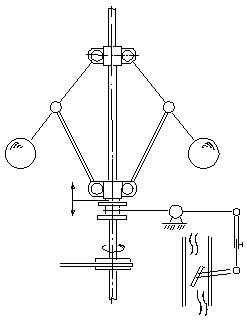| Hypercommunication - Crash Courses - Second-order Systems Theory [ Hyper-Library ] [ Hyper-Lexicon ] [ back ] |
|
|
backward - Page 5 - forward |
|
My system theory has a very practical function in the history of development, it serves as a design instruction for controlled machines (note 1). The first controlled machines were constructed without (explicit) control theory. J. Watt, for example, who constructed the first industrially successful steam engine in 1765, had taken over the control mechanism, which he called Governor (helmsman) in reference to Plato, from a windmill control. The adjacent drawing by J. Watt shows the principle of the control system, which uses centrifugal force to determine the energy supply and thus the centrifugal force. J. Maxwell generalized the principles of regulation - which J. Watt had applied - in 1867 in a formal theory which he called On Governors and which, in a way, represents the first cybernetic system theory. N. Wiener made explicit reference to the governor theory by calling it cybernetics, which also means helmsman, and showed its practical relevance by interpreting it as an operative construction instruction for automata (note 2). N. Wiener realized in the construction of controlled machines - although or because his prototypical work, an anti-aircraft gun, was never successfully used - that the control used in automatons often leads to uncontrolled swinging. N. Wiener recognized in this a general problem, which was also examined by the neurophysiologist A. Rosenblueth in a completely different context. A. Rosenblueth dealt with neurological disorders such as intention tremor, in which uncontrolled muscle activity leads to a patient being unable to bring a coffee cup to the mouth without spilling it first. N. Wiener and A. Rosenblueth, together with computer pioneer J. Bigelow, developed cybernetic methods with which the upswing can be understood and in certain cases constructively prevented. In "Behavior, Purpose and Teleology", the three wrote that the behavior classes in machines and living organisms are organized in the same way. They regarded all purposeful action as a control process with feedback. In this way they laid the foundation for cybernetics, which N. Wiener was not allowed to publish as a book until 1948 due to technical war reasons. |

|
Generally speaking, the interdisciplinary nature of cybernetics (and systems theory) is emphasized. But I see the essential aspect of cybernetics in the fact that cybernetics has abolished the distinction between analysis and construction. N. Wiener has described cybernetics as a science of "regulation and communication in animals and machines". By generalising the principles of regulation to machines and living organisms, which are of course not produced like machines, the engineer's design instruction was transformed into an explanatory model for regulated behaviour (note 3). In retrospect, the mechanical engineer now also appears as an analyst who "explains" desired behavior of machines as phenomena by means of constructions. Each construction "explains" how the phenomenon that is created with it comes about. Cybernetic systems theory is therefore not only a construction instruction for machines, but a general basis for explanation. In the narrower, theoretical sense, systems theory always serves to explain (see note 1).
The subject of my systems theory is explanation. So I will talk about amoebas, hurricanes or societies only in so far as these occur in my explanations. Of course, you can make quite good explanations even without systems theory, I will come back to that (note 4). In a way, the whole of science, not just systems theory, can be understood as a search for explanations. With systems theory I make myself aware of my explanations and therefore conscious explanations. What I can make conscious offers me better entertainment and more specific possibilities of intervention. Conversely, explaining is not a very specific theoretical subject. I can read arbitrary system theories in such a way that they do not deal with their objects, but with the explanation of these objects. However, I can read not only system theories but theories as a whole. From a system theory I expect a specific way of explaining it and above all that this explanation has priority over any other objects in theory (see note 1 to introduction). What is interesting from a systems theory perspective is not how amoebas and societies behave, but how I explain their behavior (note 5).
The distinction between behaviour and the explanation of behaviour is based on the distinction between the images and what is depicted, which I use throughout my systems theory - in the terminology of N. Luhmann as a guiding distinction. As long as I observe amoebas or societies from the outside as objects, the distinction is unproblematic, but it will move to the centre of the observer's observation later, when so-called theories of representation are replaced by constructivisms.
|
|
backward - Page 5 - forward |